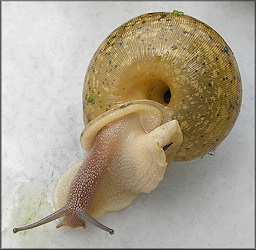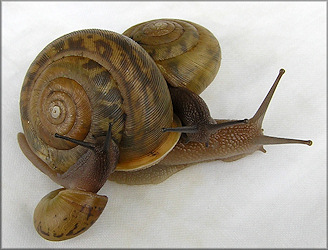Classification
Domain: Eukaryota
Kingdom: Animalia
Phylum: Mollusca
Class: Gastropoda
Order: Stylommatophora
Family: Polygyridae
Genus: Appalachina
Specific Epithet: chilhoweensis
Scientific name: Appalachina chilhoweensis (J. Lewis, 1870)
The Latin origin of Appalachina chilhoweensis species is uknown.
Synonyms:
Mesodon Chihoweensis (J. Lewis)
Common English Name:
Queen Crater- most likely comes from the crater-like shape
created by the whorls on the dorsal side. Can be seen when
Appalachina
chilhoweensis is upside down (shown in the photo above).
Appalachina chilhoweensis (J. Lewis, 1870) consists of species name as well as the authority name.
Description of Classification:
-Domain Eukaryota: is classified by containing a nucleus and membrane bound organelles (Hickman, 2009).
-Kingdom Animalia: is classified by being multicellular and heterotrophic (Hickman, 2009).
-Phylum Mollusca: in latin, translates to "soft body". The synapomorphies shared by these organisms in the the Phylum Mollusca; are a radula, posterior mantle cavity with one or more pairs of gills, chambered heart with atria and ventricle, muscular foot, calcarious spicules produced by mantle shell gland, mantle, and reduction of coelom and development of hemocoel (Hickman, 2009).
-Class Gastropoda: in latin, translates to "stomach foot". Gastropoda is the largest and most diverse class in the Phylum Mollusca, conatining about 70,000 living and 15,000 fossil species (Hickman, 2009). Gastropods are basically bilaterally symmetrical, but because of torsion, a twisting process that occurs during development , the visceral mass has become asymmetrical (Hickman, 2009). Gastropods are often sluggish, sedentary animals, because of their heavy shells and slow locomotor organs (Hickman, 2009). Gastropods indirect development consist of a trochopohore and a veliger larval stages.
Order Stylommatophora consists of snails that are fully terrestrial. They have the cleidoic eggs that have giving rise to embryos with direct development (Wilbur, 1984). This special adaptation completes a successful transition from a marine environment to a terrestrial environment (Wilbur, 1984).
-Family Polygyridae: can be found widely spread across North America. Occurring in eastern Canada, British Columbia, southern Alaska, and in all of the United States except Wyoming, Colorado, Utah, and Nevada (Pilsbry, 1940). A character of this group is a one-colored shell varying from discoidal or len-sphaped to globose-conic aperture (Pilsbry, 1940). This aperture has reflected lip which is often toothed (Pilsbry, 1940). Also the genitalia is without dart apparatus, and the penis is simple or continued in an epiphallus with a very short flagellum or none (Pilsbry, 1940). The family also has a narrow kidney about two or three times the length of their pericardium (Pilsbry, 1940).
 -Genus
Appalachina is composed of snails that have large
depressed shells that are openly umbilicated, with either
smooth or radially striate embronic whorls (Pilsbry,
1940). They
also have a rounded-lunate aperture and a very long penis, its
length about 1.5 times the diameter of shell
(Pilsbry, 1940).
-Genus
Appalachina is composed of snails that have large
depressed shells that are openly umbilicated, with either
smooth or radially striate embronic whorls (Pilsbry,
1940). They
also have a rounded-lunate aperture and a very long penis, its
length about 1.5 times the diameter of shell
(Pilsbry, 1940).
-Species chilhoweensis has a shell width for an adult of 26.5-42 mm, that usually consists of 6-6.5 whorls (Pilsbry, 1940). The shell's color is typically a yellow-brown and has a silky sheen. Another similarity is the parietal callus is thick and it is typically toothless, but sometimes is bearing a small and low oblique tooth (Pilsbry, 1940).
Next we will look at the distribution and type of habitat the Appalachina chilhoweensis located in!!!